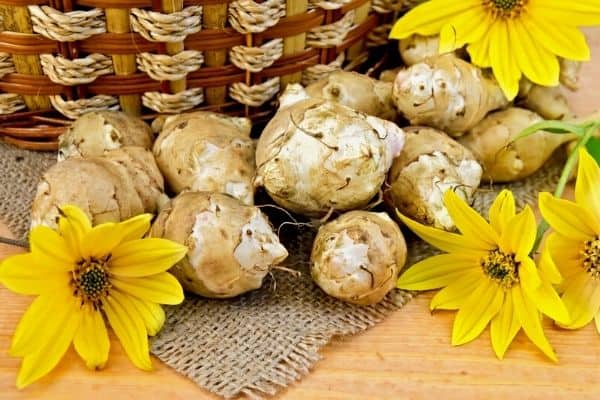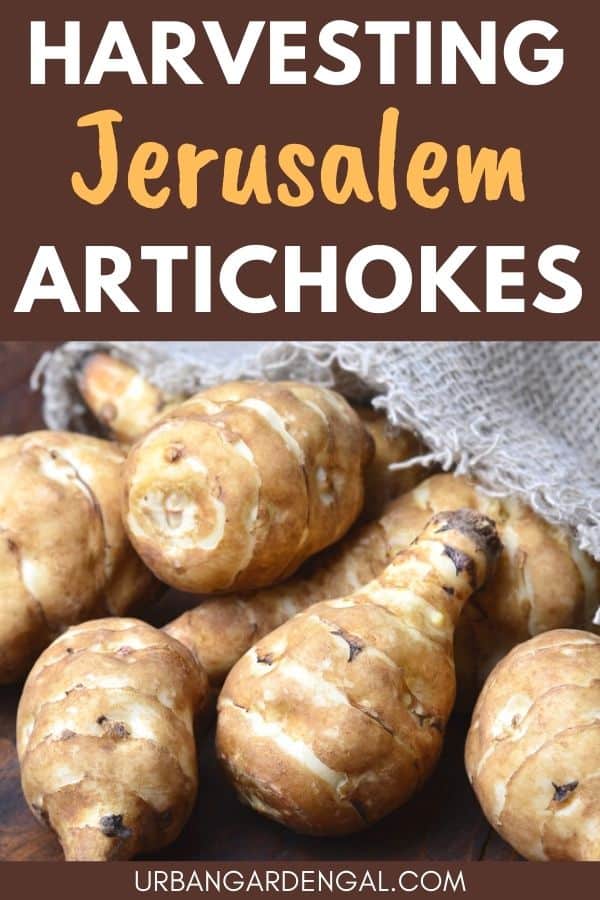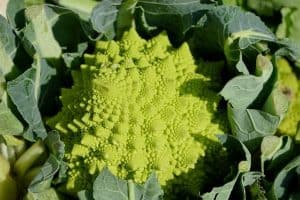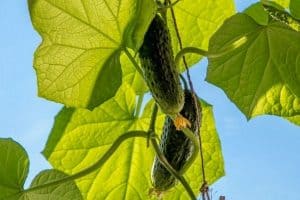Harvesting Jerusalem artichokes from your vegetable garden is easy to do and you can dig them up fresh from the garden as you need them.
In this article I’ll tell you when Jerusalem artichokes are ready to harvest, the best way to harvest them, and give you tips for cooking and storing Jerusalem artichokes from your vegetable garden.
This post contains affiliate links. Please read the disclosure for more info.

Jerusalem Artichokes (Helianthus tuberosus) are also known as sunchokes, although they’re not a variety of artichoke.
They actually belong to the sunflower family and produce bright yellow flowers that look just like sunflowers.
Jerusalem artichoke plants produce tubers under the ground similar to potatoes, but they can be left in the ground for many months before they need to be harvested.
You can remove the flowers to maximize tuber production but I like the look of the flowers in the garden.

When are Jerusalem artichokes ready to harvest?
Jerusalem artichokes are ready to harvest about 130 days (18 weeks) after planting.
You can begin harvesting Jerusalem artichokes in late fall and continue harvesting until winter.
The best time to pick Jerusalem artichokes is after the first frost, when the plants start to wither.
It’s best to stop watering the plants when they begin to wilt to prevent the tubers going rotten.
If you want to extend the harvest period, leave the tubers in the ground and place a thick layer of mulch on top of the soil to prevent the soil from freezing.
If you live somewhere with a very cold climate you’ll need to harvest all of the tubers before the ground freezes.

How to dig up Jerusalem artichokes
Cut back the wilted foliage with garden shears and then use a garden fork to loosen the soil two feet (60 cm) around each plant.
Use your hands to remove some of the soil and gently separate the tubers from the plant.
You’ll probably have one large cluster but if you search through the soil you should see some more smaller tubers.
Take care to avoid bruising the tubers or breaking them apart because they won’t last as long if they’re damaged.
You can also leave some of the tubers in the ground to grow the next year.

How to cook Jerusalem artichokes
Jerusalem Artichokes have a sweet nutty flavor and are very versatile in the kitchen.
They can be eaten raw, boiled, steamed, roasted, fried or added to soups, stews and stir fries.
You can also grate them into salads for texture and flavor or mash them with potatoes.
Large Jerusalem artichokes with knobbly skin can be peeled before cooking but the smaller ones can just be scrubbed well before cooking.
A quick way to enjoy Jerusalem artichokes is to cut them thinly and roast them in the oven to make delicious chips like in the photo below.

How to store Jerusalem artichokes
Rinse them under running water to remove the soil if you’re going to store them in the refrigerator.
Jerusalem artichokes will keep in the fridge for about 10 days.
You can also store Jerusalem artichokes in moist sawdust or sand for a couple of months.
Take care that they don’t dry out too much because they’ll shrivel up quickly.
Jerusalem artichokes don’t freeze well so they’re best used soon after harvesting.
RELATED ARTICLES
- How Long Do Potatoes Take To Grow
- Pumpkin Growth Stages
- 12 Small Vegetable Plants
- How To Harvest Turmeric
- How to Grow Globe Artichoke Flowers
So there are my tips for harvesting Jerusalem artichokes (sunchokes) from your garden.
Jerusalem artichokes are a great addition to your vegetable patch, both for their lovely flowers and tasty tubers.
Do you have any comments or questions about harvesting Jerusalem artichokes? Let me know in the comments below.
Are you on Pinterest? I have boards dedicated to Vegetable Gardening and Gardening Tips that you may enjoy. You can also find me on Facebook.






I keep Jerusalem artichokes in the fridge for 3 – 4 months after harvesting, depending on if I forget about some. The trick is NOT to wash them…just shake off the dirt and pile them in a small breathable box or vegie bag with holes. They have to be in a cold part of the fridge, or they will eventually sprout. If they get too withered, just set in a bowl of water overnight and they will plump back up. They are great scrubbed and sliced raw in salads, like Jicama. Oven roasting turns breaks down some of the inulin fiber into sugars, so they are sweeter cooked. I use them instead of potatoes in any recipe to reduce carb content and increase fiber.
Glad there’s the one comment addressing the inulin consequence, at least! It isn’t just here, 95% of growing and recipe articles about sunchokes ignore the chemistry involved in eating sunchokes, and that’s a bigger shame than the gas.
Folks unaware of eating sunchokes aren’t likely to eat them again, after one meal of them.
If you do try them, first look up the tips to prepare them and minimize the inulin metabolizing, there are several options. They are tasty and easy to grow and worth the extra steps. Or, if you have boys in the house, cook sunchokes straight and don’t tell them what’ll happen, they’ll love it!
My ‘chokes are going to be pulled in a few days and there will be enough pieces left for the patch to come back in the spring. They grow well here but don’t get a chance to blossom much. When I first planted them 15 years ago, they struggled to get real deep now they are only 6 inches or so deep. Our land (central Labrador) freezes 3 ft. plus but these ones have learned how to survive.